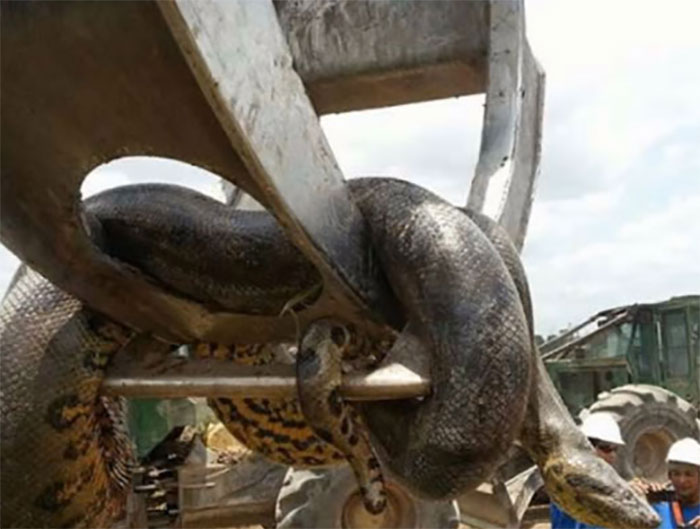Imagine this: you’re enjoying a peaceful stroll through the woods, the sun dappling through the leaves, the air heavy with the scent of pine. Suddenly, a massive shadow blocks the light. You look up and – gulp – a serpent, wider than your car, with scales as big as dinner plates, stares back at you. Sound like something out of a horror movie? Believe it or not, this scenario, albeit exaggerated, isn’t entirely impossible. While a 700-pound snake isn’t exactly roaming the North Carolina forests, the prospect raises a fascinating question: could such a creature exist, and if so, what would it take to make it a reality?

Image: www.walmart.com
The very idea of a snake weighing 700 pounds conjures up visions of giant, prehistoric monsters, creatures that would make even the most seasoned snake handler tremble. But how realistic is it? To answer that, we need to dive into the world of snakes, their anatomy, and the limits of their size potential. While it might be an entertaining thought experiment, our reality is different. The largest living snake, the reticulated python, can reach lengths of 23 feet and weigh upwards of 600 pounds. This is already impressive, but the 700lb mark is a stretch, even for a hypothetical giant snake.
The Anatomy of a Giant
To understand why a 700lb snake is unlikely, we need to understand the basic anatomy of these reptiles. Snakes are, for the most part, built for long, slender bodies, optimized for squeezing through tight spaces and hunting prey. Their skeletal structure is designed for flexibility and locomotion, not for massive size.
Their ribs are thin and flexible, anchored to vertebrae that are light and strong. This allows snakes to slither with remarkable agility. Now imagine trying to support a 700lb body on this framework. The sheer weight would put immense pressure on their bones, muscles, and internal organs. This wouldn’t just cause mobility issues, it could also lead to serious health complications.
Breathing, Digestion, and Reproduction
A snake’s respiratory system also presents challenges. They breathe through lungs, which are long, tubular structures extending the length of their body. Imagine trying to pump air through that lung system to oxygenate a 700lb mass – it would be a tremendous strain, requiring a massively complex and oversized lung system just to keep the creature alive.
Digestion is another hurdle. Snakes are carnivores, swallowing prey whole and digesting it slowly. A 700lb snake would need to consume enormous quantities of food to sustain itself. The sheer volume of prey needed to fuel such a beast would be impractical, especially considering the limitations of their digestive system.
Even reproduction poses a challenge. Snakes lay eggs, and the size of these eggs would scale up with the size of the snake. Imagine the logistics of a 700lb snake laying eggs – a logistical nightmare!
The Environmental Factor
The environment plays a crucial role in the size and distribution of any creature. Snakes, particularly the giant ones, rely on specific habitats for food, shelter, and breeding. A 700lb snake would require an enormous territory to support itself, with suitable prey and nesting areas. This, combined with the logistical challenges of food, oxygenation, and reproduction, makes the existence of such a creature in the wild highly unlikely. While we find giant snakes fascinating, their size has natural limitations. It’s important to remember that a 700lb snake, while a captivating thought experiment, would be a product of an extreme and highly improbable genetic and environmental circumstance.

Image: tammy-hollywq.blogspot.com
What about the 700lb Snake in NC?
Now, let’s address the elephant (or perhaps giant snake) in the room: the rumored 700lb snake in North Carolina. This tale, often circulating through campfire stories and local legends, is probably nothing more than a tall tale. While it’s fun to imagine a giant serpent lurking in the Carolina backwoods, there’s no scientific evidence to support its existence. Even if we consider the possibility of a colossal snake evolving over time, the geological and ecological conditions of North Carolina don’t match the requirements for such a creature to thrive.
The truth of the matter is that the largest snakes found in North Carolina are the Eastern Diamondback Rattlesnake, which can reach around 6 feet in length, and the Eastern Indigo Snake, which can grow to about 8 feet. These snakes, though impressive in size, are nowhere near the 700lb mark. The chances of a 700lb snake existing, especially in North Carolina, are practically nil. So, if you’re hiking in the woods, keep your eyes peeled for the more common (and definitely smaller) snakes, but feel free to leave the 700lb serpent fantasies to the realm of folklore.
The Appeal of the Giant Snake
The fascination with giant snakes is more than just a curiosity. It’s a reminder of the incredible diversity and power of the natural world. We’re drawn to the idea of creatures that push the boundaries of size and strength, creatures that represent the untamed forces of nature. Tales of giant snakes, even if fictional, tap into our primal fears and awe of the unknown. They remind us that the world is full of mysteries, and that even in the modern age, there’s still room for wonder and imagination.
700 Lb Snake Found In Nc
https://youtube.com/watch?v=z6Lb2o866DY
Conclusion
While the existence of a 700lb snake in North Carolina (or anywhere else) remains highly improbable, the question itself is a testament to our fascination with the seemingly impossible. The notion of a gigantic reptilian creature challenges our understanding of the limits of nature and fuels our imagination. So, the next time you hear a tale of a giant snake, take it with a grain of salt, but don’t dismiss the powerful reminder of the mystery and awe that the natural world holds.






